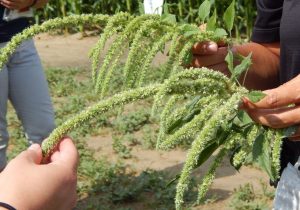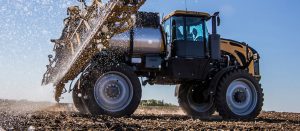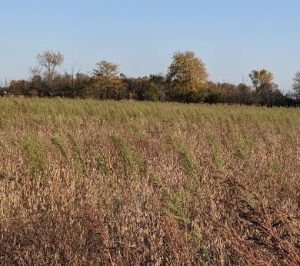The top weeds for 2020
By Dusty Sonnenberg, CCA, Field Leader
After a challenging 2019, four specific weeds should be on every farmer’s radar for 2020: waterhemp, Palmer amaranth, giant ragweed, and marestail.
Waterhemp and Palmer amaranth

In terms of waterhemp, there was significant seed production potential in 2019.
“I have seen an increase in waterhemp in 2019, especially with all the prevent plant acres, and that is going to mean big problems for some farmers in 2020,” said Kenny Schilling, retail market manager for FMC Corporation. “If you know you are going to have waterhemp issues in the 2020 soybean crop, a farmer needs to plan on using a dicamba or Liberty soybean in that field.
“It is recommended to use a Group 14 and Group 15 Family herbicide in the pre-emerge application and follow it up with a Group 15 Family herbicide again in the post-emerge application, combined with the chemistry from the herbicide resistant soybean that was planted. Most farmers are using either a Group 14 or Group 15, but they really need to use a herbicide from both groups.”
Farmers need to catch waterhemp early.
“Farmers need to learn to treat the seed, not the weed,” Shilling said. “Ideally we need to stop it before it germinates.  Waterhemp will grow 1.25 inches each day after it germinates. To be effective, we really need to get it before it gets to the 6- to 8-inch range. At that point it is just too big, and becomes very difficult to control. There are basically 5 days from the time waterhemp germinates until it is a problem, so an application needs to be made before day 5.”
Waterhemp will grow 1.25 inches each day after it germinates. To be effective, we really need to get it before it gets to the 6- to 8-inch range. At that point it is just too big, and becomes very difficult to control. There are basically 5 days from the time waterhemp germinates until it is a problem, so an application needs to be made before day 5.”
Don Schneider, business representative for BASF concurs with Shilling’s concern. Schneider wants farmers to assess their waterhemp going to be based on how much seed was produced on the acres that were uncontrolled in 2019?
“This is a real issue that needs to have special attention in 2020 if a farmer finds it spread into their field in 2019. Waterhemp is known for its prolific seed production and having a very small, light seed that can easily be spread by the wind. It is a fast grower, and it produces seed throughout the summer,” Schneider said.
Schneider recommends that if a farmer has waterhemp that went to seed, they should plan to go after it with an early spring burndown application or early post-emerge application.
“The farmer will need to have their weapons fully loaded to tackle this weed in 2020,” Schneider said.
Schilling recommends herbicide resistant soybeans when battling tough weeds.
“Farmers should plan on planting a dicamba bean if they know they have a problem. If they have concerns about the risk of the dicamba products, then a Liberty resistant soybean or an Enlist bean (resistant to 2,4-D or glyphosate), and Liberty (glufosinate) should be selected to give the most options for in season control.”
Waterhemp is similar to Palmer amaranth in that it is a prolific seed producer. One Palmer amaranth plant is capable of producing 250,000 to 500,000 seeds. It also germinates the entire growing season from early May until mid-August.
“Farmers really need to layer another residual with the post emerge pass for control of these weeds,” Schneider said.
Neil Badenhop, sales representative for Valent USA, is concerned that waterhemp may have gotten established and gone to seed in either unplanted or untreated fields this past summer. The farmers may not realize the potential problem they have on their hands.
“Proper identification of the weed problem is the first step. Farmers may misidentify waterhemp, thinking it is common lambsquarters,” Badenhop said. “The two weeds look very similar if you do not know what you’re looking for.”
Giant ragweed
Not all residual herbicides are created equal. A farmer needs to study the Ohio, Indiana and Illinois Weed Control Guide, and evaluate differences in residual herbicides. Different herbicides work better on different weed complexes. Farmers need to purchase an effective herbicide based on individual weed populations.
Some farmers may be lulled into a false sense of security with their “standard” chemistry program. Along with waterhemp, giant ragweed has become a greater concern and creates real challenges in management, Shilling said.
“The problem is if a farmer has both waterhemp and giant ragweed issues, the products that are good on waterhemp are not as good on giant ragweed,” Shilling said. “If there are giant ragweed concerns, a farmer should look at products in the Group 2 Family that contain First Rate or Classic.”
Schneider feels that to effectively battle giant ragweed, both a pre-emerge and post-emerge application strategy are necessary.
“Giant ragweed has a large seed and has a later germination than other weeds, so it causes issues for a pre-emerge application alone without a good post-emerge application to follow-up. Liberty and Engenia are both good options to add to either a pre- or post- application on the respective traited soybeans, and they are both also good on marestail,” Schneider said.
Marestail

Glyphosate resistant marestail continues to be a problem in fields that have not seen an adjustment in the herbicide program to address the issue.
For farmers with multiple herbicide resistant weed species present, a dicamba resistant soybean is recommended. Dicamba-resistant soybeans, regardless of the company and specific product (Engenia, Xtendimax and FeXapan) are labeled to have the product applied either pre-plant, pre-emerge, or post-emerge. The chemistries have been formulated to reduce the volatility and risk of inversion and off-site movement.
Badenhop has been very impressed with the reformulations and less volatility now compared to his prior experience with the original formulation of dicamba and off target movement risk.
“I thought there would be a lot more issues. The new technology has really lowered the vulnerability and risk. The companies have done a great job,” Badenhop said. “Most complaints seem to be a result of a misapplication from the label directions. As a result, more restrictions continue to be placed on the use of the products in other states.”
Valent USA does not have a dicamba product on the market. Engenia is the BASF dicamba product.
Schneider said the companies that manufacture the dicamba product offer required training for farmers intending to apply it in the 2020 growing season.
“The product label requires dicamba training for anyone who will be applying the dicamba product in 2020,” Schneider said. “This is a two-year label approved by the U.S. EPA. Individual states can have additional stipulations. Ohio has elected to stay with the federal label.”